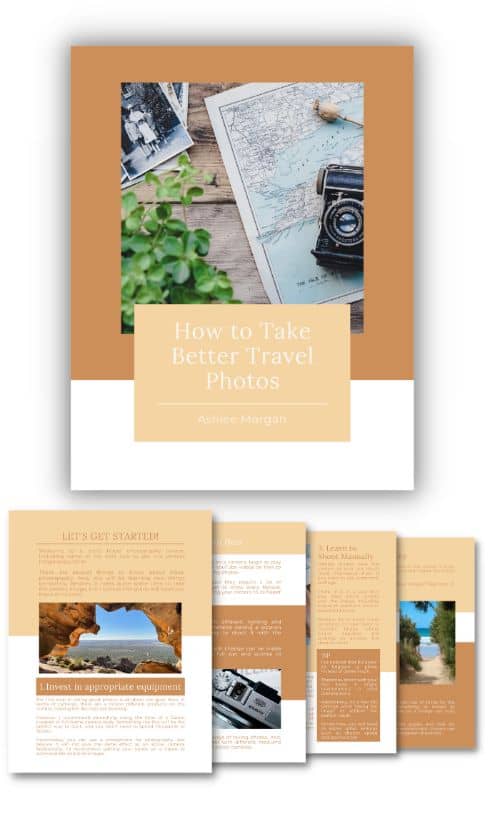Scuba diving in Koh Tao has to be one of the most incredible things you could ever experience. Imagine cruising underwater and getting the opportunity to swim with stingrays, anemones, clownfish, sea snakes, octopuses and so much more.
You truly won’t believe your eyes when exploring the magnificent dive sites off the coast of the island and there are some truly spectacular locations to visit. Not to mention, scuba diving in Koh Tao is one of the cheapest locations in the world. So, you’d be silly to pass up the offer!
Continue reading my insider’s guide for plenty of information on diving, courses and my personal experience diving on Koh Tao.
Disclaimer: Some of the links in this post are affiliate links. This means that I may earn a small commission on purchases made through these links at no extra cost to you. Moreover, you can read my full affiliate disclosure here.
What is Scuba Diving?
Scuba Diving is an experience in which a group of people wear a cylinder tank to supply oxygen while exploring underwater. Moreover, divers will wear eye masks, buoyancy control devices, cylinder tanks, regulators, fins and in cooler climates, wetsuits.
Scuba diving provides humans with the chance to spend a much longer period of time underwater than the typical freediving or snorkelling experience can provide. Besides, it’s a great way to explore deeper parts of the ocean and view life underwater.
Where is Koh Tao?
Koh Tao is a small island in the South Eastern part of Thailand. Moreover, its much larger neighbours Koh Phangan and Koh Samui are also excellent locations to experience scuba diving.
Is Scuba Diving in Koh Tao Safe?
Yes! Scuba diving in Koh Tao is extremely safe! Of course, there are many safety measures that all divers need to keep in mind. However, if you follow the rules and stick with your instructor, you should have no issues diving safely.



Is Scuba Diving in Koh Tao Worth It?
I truly believe that Koh Tao has some of the best dive sites, especially in Thailand. I’ve completed a handful of dives, and the sites in Koh Tao are absolutely incredible!
I go into further detail later in the post about some of the dive sites, and what I recommend checking out.


How Much Does It Cost to Scuba Dive in Koh Tao?
On average, you’re looking at around 11,100 THB ($470 AUD) to complete your Open Water 20 certification. Furthermore, you can look at getting packages of 10 fun dives (once qualified) for around 8,000 THB ($338 AUD), which is an incredible deal!
For the most part, the majority of the schools on the island offer similar and competitive prices. Nonetheless, for the best deal, I recommend checking with your accommodation to see if they are affiliated with a dive school and can give you a discount.
Personally, I stayed with Summer Hostel and received a discount to complete my course with Roctopus. Not to mention, Koh Tao is one of the cheapest places in the world in which you can receive your license, so I highly recommend checking it out.
These are a couple of options for courses you can check out:
How to Pick a Diving School
Now it comes down to picking a dive school. This is actually very important and something I didn’t actually realise. Though, I was lucky that things worked out for me!
Firstly, you need to consider the size of the school. There are a couple of main diving schools on the island by the names of Big Blue and Ban’s. These courses include a lot of students and they go out in large groups.
Secondly, a smaller school may be the best bet if you prefer to receive one-on-one attention. Furthermore, if you feel as though you want to ask plenty of questions and receive lots of support, this is definitely the way to go.
I chose a smaller school (Roctopus) and loved the individual attention I could receive from my instructor. It made the diving experience much more comfortable.
Read more: 10 Best Restaurants in Koh Tao: The Best Places to Eat
What Is the Experience and Course Like?
The course is divided into four days and you will get a total of four dives in the open ocean. Depending on which company you do the course with, the pricing may vary slightly.
You will learn everything you need to know to become open-water certified and gain a qualification. Then, you can dive anywhere in the world to a total depth of 20 metres.
Furthermore, if you wish to increase your qualification, you can move on to do an advanced course, rescue courses etc.
For now, let’s discuss the breakdown of the course:
Day One
The first day of the course is pretty simple. You will meet your diving instructor and buddies that you will be completing the course and dives with. My group consisted of my instructor and one other dive buddy.
This day usually begins at about 4:00 PM and you will go through some of the theory to learn how to dive. You will also get to know your instructor and buddies a little bit more and get to create a sense of team.
The academic session usually runs for about a couple of hours, and you will be sent home with some online homework. Keep in mind, you will need to read through lots of information and get 100% on all of the quizzes required. However, we were allowed to work together and discuss answers.
I really liked the fact that I had a small group as I could pick the brains of my instructor, ask plenty of questions and receive plenty of one-on-one help. I tend to get quite anxious, and this was a great way to receive heaps of support.

Day Two
Day two begins a little earlier with some academics starting at around 8:00 AM. And, this is a great way to get the body clock ready for the upcoming dives. You will spend a couple of hours brushing up on the theory work and receive a little more homework for the night.
Next up, in the afternoon is the pool session. This is an excellent chance to practice with the gear and get comfortable breathing through the regulator underwater. Additionally, you will practice a few skills so that you are ready to swim in the ocean.
Finally, the pool session takes a couple of hours and you will walk away feeling much more prepared for the upcoming days. Now, the exciting part is just yet to begin!
Day Three
It’s time to dive! Your instructor will go over the final bits of homework with you and ensure that you received 100% on all the theory work. And, this is an excellent time to ask any additional questions that you may need.
Furthermore, you will also go through some hand signals, and your instructor should test you on these so that you are up to scratch.
Now it’s time to jump on board the boat and head to the first dive site. This is where the fun begins! You will descend to a depth of about 10m and do some practice of the skills with your instructor.
This includes half flooding the mask, completely flooding the mask, taking out your regulator, taking off the weight belt, removing your buoyancy control device and sharing a spare regulator with your buddy.
Once your instructor is happy with your skills, you will get the chance to go for a swim and explore some of the underwater world. This is the best part of the dive and it feels so freeing!
After about a 40-minute dive, you will begin a slow ascent and then rest for a little while before completing dive number 2.

Day Four
The final day of the course is the absolute best part. Moreover, you will get up bright and early, head to the dive store and then make your way to the boat for the final two dives.
These are fun dives, and you get to explore two incredible dive sites before finalising your course. So, as long as your instructor is happy with your performance, you should receive your open water certification and be free to dive with a buddy anywhere in the world!
The day ends with some celebratory drinks and receiving of certificate. A fantastic way to finish the course!
Read more: Thailand Travel Tips: Everything You Need to Know
Learning New Skills
Breathing Methods
Breathing methods are a skill you will learn in the pool. And, this is the perfect time to practice getting comfortable with the regulator. A constant natural flow of breathing in and out is crucial for safe diving.
Therefore, you should never hold your breath at any time of the dive! This can be extremely dangerous and your instructor will go into more detail.
Buoyancy Control
Buoyancy control is also a part of breathing methods. Think of it this way, our lungs are like a floating device in our own bodies. When we breathe in we can float, and when we exhale we can sink.
This is a crucial skill to master as you will need to be able to use your buoyancy to float over reefs, rocks, aquatic life, urchins and so much more. A simple inhale can help you to glide over the top of a set of reef.
Hand Signals and Communication
Knowing how to communicate underwater is insanely crucial. Especially when you need to get a message across quickly. Pay lots of attention to the hand signals and practice them heaps before going underwater.
Nonetheless, you’d be surprised just how easy it is to communicate underwater. You can really get a lot across from very simple body language techniques.
Equalising
One of the worst parts of descending into the water is equalising. Moreover, this is a method to equalise your ears as you descend that avoids building pressure in your ears.
The method for equalising includes squeezing the tip of your nose and then softly blowing through the nose. This pops the pressure and helps your ears to adjust. If you find it much too difficult, head up a couple of metres as the pressure will reduce.
Tip: Never scuba dive with a cold. Having a cold makes it insanely hard to equalise and it can be a really painful process!
Reading Air Levels
Reading air levels is another critical process that must be conducted consistently throughout the dive. You will need to check your air levels and then communicate them with the instructor so that they know how much longer you can spend underwater.
Looking Out For Your Buddy
At all times of the dive, keep an eye out for your buddy and check in that they’re doing okay. Supporting each other underwater is crucial to ensure a smooth dive. And, it creates a sense of team!
Types of Diving Licenses
There is a range of licenses that you can apply for, but you have to begin with the Open Water 20 Course. Moreover, these are some of the licenses and what you can do with them (In order):
- Open Water 20: Dive to a total depth of 20m
- Advanced Open Water 30: Dive to a total depth of 30m, this is best for exploring shipwrecks
- Rescue Diver: Learn to respond to underwater emergencies
- Divemaster: Become an instructor and lead diving classes
Diving Sites on Koh Tao
Now it’s time to discuss dive sites on Koh Tao. Besides, there’s a massive range of them, it can be a little hard to pick which ones you want to do especially if you’re only booked in for a couple of fun dives.
I completed four dives which included Japenese Garden, Red Rock, Chumphon and Hin Pee Wee. Each of these was incredible, but my favourites were Chumphon and Red Rock.
Some of the most popular diving sites on Koh Tao include:
- Chumphon Pinnacle
- Three Rocks
- Japanese Garden
- Mango Bay
- White Rock
- Hin Pee Wee
Tip: Ask the dive school which dive they recommend completing. And, it’s usually best to book the dive site early in the morning, the day of. Considering, the weather can change drastically in Koh Tao and visibility may be ruined if the ocean decides to take a turn.


Read more: John Suwan Viewpoint, Koh Tao: The Best Viewpoint
Tips for Scuba Diving
There are so many things you could take away from this post, but here are a few of my tips for scuba diving that I’ve learnt along the way:
- Learning to remain calm and focus on your breathing is crucial
- Always dive with an instructor and buddy that you feel comfortable with
- Stick with your buddy and instructor at all times
- Never dive when feeling sick. A cold is the worst time to dive!
- Drink lots of water before your dive. It’s incredible how dehydrated you can become
- For those with long hair, make sure it is secured in a very high bun or low braid. Keeping your hair out of the way is very important for safety measures.
- A soapy water rinse inside of your eye mask is a great way to prevent fogging
My Personal Diving Experience with Roctopus Dive School
I completed my course with Roctopus Diving School, and to say they were fantastic throughout the entire process is the very least I could tell. I also stayed at Summer Hostel which meant that I got a discount of 1000 baht off the total price of my course.
My instructor’s name was Sean, and he was extremely thorough with teaching my dive buddy and me, insanely patient, understanding and supportive. I had a fantastic time learning about the underwater world and discovering the beauty of Koh Tao.
I learnt plenty of important skills and feel like a much more confident diver than I thought I would ever be. And, now I feel like I have the knowledge to dive anywhere in the world. Scuba diving in Koh Tao is an incredible experience that I think everyone needs to try at least once!
I highly recommend checking out Roctopus diving school. It was a fantastic experience that I’ll always be grateful for.
Finally, check out Roctopus Diving School here for more information and a place to book your dives.
Do I Recommend Diving in Koh Tao?
Koh Tao is known for having some of the best diving sites in the world, and though I haven’t had a lot of experience, I’d have to say that it was incredible.
There is a huge range of fish and aquatic creatures that I’d never seen before, the reef was stunning and the water was comfortable and warm.
If you are visiting this island and are interested in diving, I would simply tell you to bite the bullet and go for it. It’s an amazing experience and I truly believe that it was worth every cent!

Wrapping Up
In conclusion, scuba diving in Koh Tao is one of the most incredible experiences on the island. There are tonnes of beautiful dive sites, loads of great diving schools and it’s easily one of the best places to learn to dive.
Please take my advice into account, as it will give you the best headstart for getting ready to scuba dive in Koh Tao.
Finally, if you want to discover more from Thailand, please check out this section of my blog where I offer loads of content. Moreover, I am constantly updating this area of my blog bringing you the best bits of Thailand and everything you need to know. Happy reading!
Read more:
Koh Tao Pub Crawl: Thailands Best Pub Crawl
12 Things to Do in Koh Tao, Thailand: An Insiders Guide








